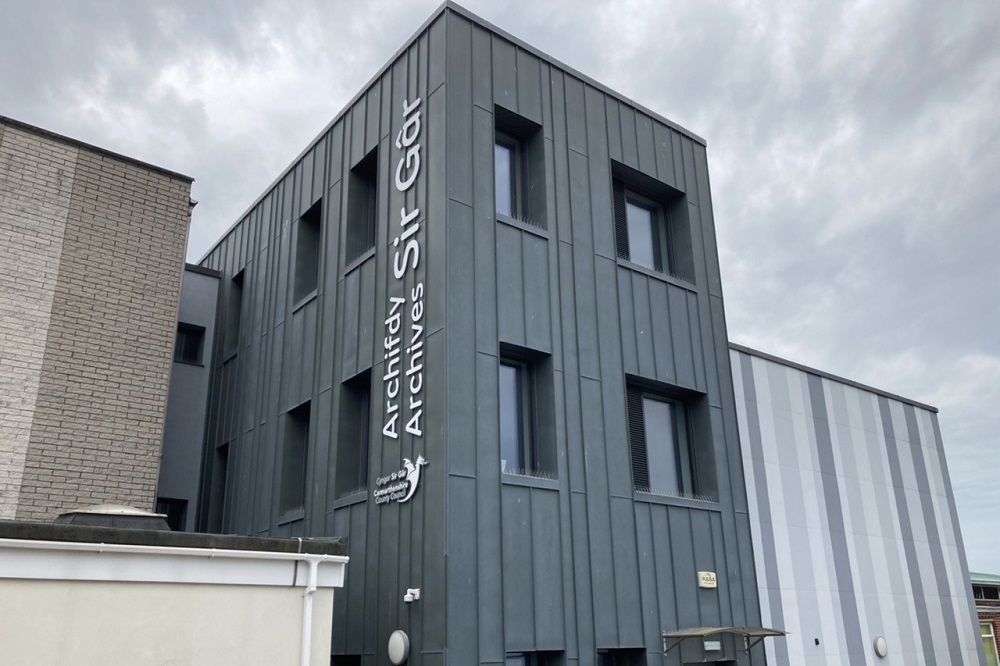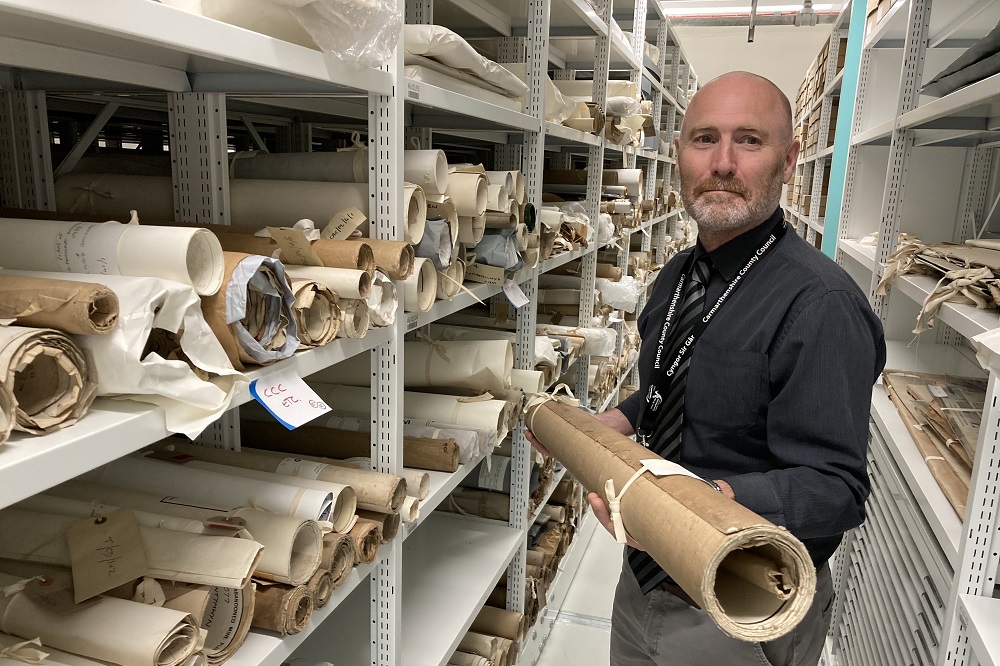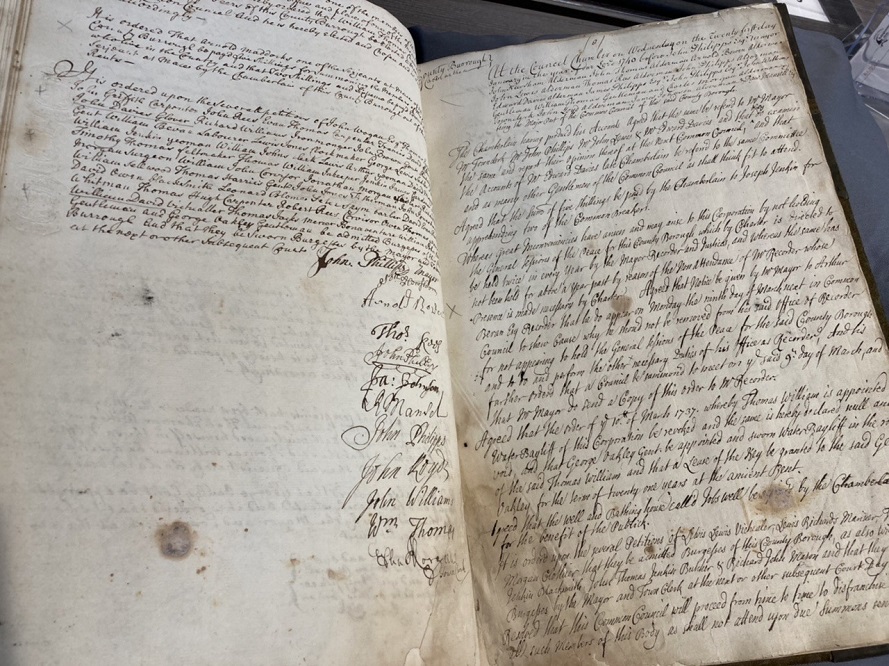Behind the scenes at the archives: a magical history tour

Richard Youle, local democracy reporter
Knowing where you can and can’t fish isn’t a trivial matter, and it seems our forebears thought so as well.
Nestling in the heart of Carmarthenshire Archives’ new building are documents cataloguing fishing rights on the River Towy dating back to the 13th Century.
They are the earliest collections of a treasure trove of maps, plans, ledgers, books, sketches, photos and glass plate negatives at the building at the rear of Carmarthen Library, St Peter’s Street.
To give you a sense of how many there are, if laid out from end to end the collection would stretch four miles.
The new £2.2 million building has been built to Passivhaus standards, meaning it has an airtight fabric and is extremely energy efficient.
Hayden Burns, archives transformation manager, said maintaining a 17C temperature and 45% humidity was especially important for the two main storage rooms – known as strong rooms.

Capacity to grow
The building opened to the public on July 13, closing the chapter on a tricky few years for the county’s archives service, during which time the collection was stored in different buildings including one where a significant mould issue came to light in 2014.
The affected documents were transferred to specialists in Oxford who fumigated and cleaned them. They then returned to Wales and were held in established collections such as the Glamorgan Archives, Cardiff, and the Richard Burton Archives at Swansea University.
“The council (Carmarthenshire), acutely aware of the importance of the collection and the needs of the community, decided to invest in a new archives building,” said Mr Burns.
The building has three levels and includes a public search room, office space, a digitisation and preservation suite, the two strong rooms, and enough capacity to grow the collection for the next 25 years.
Should fire break out, an automatic nitrogen argon gas fire suppression system will kick in.
Felons’ register
Mr Burns said the collection had a particularly comprehensive record of landed estates in the historic county of Carmarthenshire. Names such as Cawdor, Stepney, Aberglasney and Glasbrook will mean something to many residents today.
There are estate and tithe maps going back to the 17th Century, details of owners and renters of fields, various taxation records, and shipping registers – the administrative bread and butter of its day.
The collection also has records of courts of quarter sessions, where civil and criminal appeals and criminal charges were heard, and petty sessions where criminal cases were held.
“I think one of the most interesting collections is the felons’ register from the 19th Century, which includes photographs of the felons,” said Mr Burns.
Some of those found guilty for crimes such as stealing sheep or cutlery found themselves transported to distant lands.
Family history
The collection also provides evidence of decisions made by the council and its predecessor bodies going back to 1889.
There are parish records – a good starting point, said Mr Burns, if you wanted to trace your family history.
Rather than just store documents, the service is always on the lookout for new documents to fill gaps in the collection – particularly groups which aren’t well represented.
People regularly ring up to say they have things which might interest the archivists.
“I will ask about the volume (of the material offered) and its condition,” said Mr Burns. “Then we will have a look – in nine out of ten cases we won’t keep them all.”
Items which need repairing are attended to, and then the new addition to the collection is catalogued and uploaded digitally onto the archives hub – there for anyone in the world to see – in a process known as accession.

Fascinating stories
Mr Burns grew up in Galway, Ireland, studied an archives course at Aberystwyth, and was the county archivist for Anglesey before taking up his Carmarthenshire post in November 2020.
“I love it,” said the 54-year-old. “Every day is different. People think it’s a very academic job, but it’s not. It’s a practical job. You need many skills.”
It includes contacting schools and other education organisations and getting the word out more generally to the community.
Mr Burns is one of two archivists employed in the building. There are also two search room assistants, with support from volunteers and colleagues in the adjacent library.
Speaking just ahead of the public opening, Cllr Gareth John, cabinet member for regeneration, leisure, culture and tourism, said: “I am delighted that our archives collection is now back where it belongs in Carmarthenshire, full of fascinating stories of people and places, a wealth of material is available to the public for study and research.
“This new building has been purpose-built to the highest standards and will make sure our archives are protected from all potential risks of damage or loss.”
The strong rooms with their rows of shelving are simple, functional. What they contain is a different story.
I look at an impeccably-written page from The Book of Orders of the County Borough Carmarthen, from 1738 to 1757, and think of the wheel of time’s slow turn and the hopes, dreams and sorrows of those it aged.
Support our Nation today
For the price of a cup of coffee a month you can help us create an independent, not-for-profit, national news service for the people of Wales, by the people of Wales.





An Aladdin’s cave, how lucky is Sir Gar to have such a fine building. Is it a coincidence that he was the county archivist for Ynys Mon after the interesting piece on the photographic plates found in a skip?
My local Archivist, Merfyn Wyn Tomas of Dolgellau has published a series of books on all aspects of Dolgellau, for which we are truly grateful…